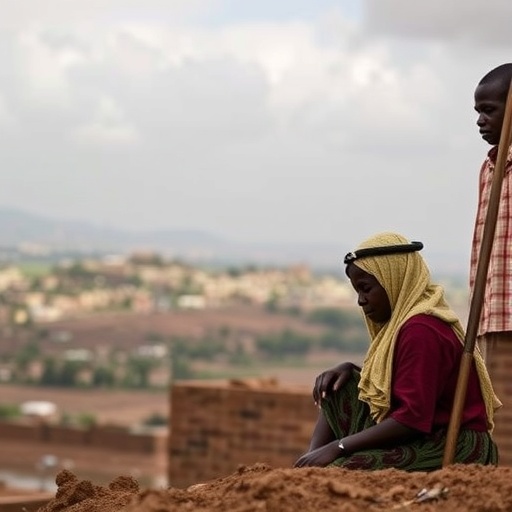Post-Traumatic Stress Disorder Among Youths in War-Torn Northeast Ethiopia: An Alarming Prevalence and Its Multifaceted Drivers
In the shadows of conflict, the youth of Northeast Ethiopia’s Kobo Town face an invisible battle as profound as the war that ravages their environment. A groundbreaking study published in BMC Psychiatry brings to light the alarming prevalence of post-traumatic stress disorder (PTSD) symptoms among these young individuals, painting a stark picture of mental health crisis in war-affected zones.
The study, grounded in rigorous community-based cross-sectional research, assessed 595 young participants using the standardized Post-traumatic Stress Disorder Checklist (PCL-5). Employing advanced statistical analyses through SPSS, including bivariable and multivariable logistic regressions, the researchers meticulously unearthed factors significantly associated with PTSD symptoms. The findings illustrate not just the scale of PTSD but also the interwoven complexity of its determinants in a war-torn context.
Strikingly, the prevalence of PTSD symptoms among the youths surveyed stood at an overwhelming 62.2%, with confidence intervals reinforcing the robustness of this finding. This prevalence underscores an urgent public health dimension that commands international attention. Globally, the increase in youth affected by PTSD due to violent conflict is a grim reality, but regional specificity such as this study provides critical insights tailored to the Ethiopian context.
The gender differential in PTSD vulnerability emerged distinctly, with females demonstrating more than double the likelihood of experiencing PTSD symptoms compared to their male counterparts. This gender disparity resonates with global trends reflecting differential exposure, social roles, and coping mechanisms among young women in conflict settings, which exacerbate their psychological burden.
Childhood trauma surfaces as a formidable contributor to PTSD manifestation among these youths. Early life adversities compound the stress from war exposure, creating a cascading impact on psychological resilience. The study elucidates how formative traumatic experiences can sensitize individuals to later stressors, amplifying PTSD risk.
Mental health comorbidities present another layer of complexity. Youths exhibiting symptoms of depression and anxiety were found to have significantly increased odds of PTSD. These findings align with the broader psychiatric literature positing a bidirectional and intertwined relationship between PTSD and other affective disorders, particularly in populations undergoing violent upheaval.
Physical injuries sustained during wartime emerged as potent drivers of PTSD symptoms. The trauma of bodily harm, coupled with the environmental stressors inherent in war zones, contributes to the lasting neuropsychological and emotional distress characteristic of PTSD. These injuries, beyond their immediate physical ramifications, imprint enduring scars on mental health.
Social support, or the lack thereof, delineates a critical determinant of mental well-being in adverse circumstances. The study’s revelation that poor social support is associated with more than threefold increased odds of PTSD among youths spotlights the buffering role social networks and community cohesion play in mitigating psychological trauma.
The research methodology employed standard diagnostic tools alongside sophisticated statistical rigor, enhancing the reliability of the conclusions drawn. However, the complex interplay of biological, psychological, and social factors underscores the necessity for multifaceted intervention strategies tailored to the unique context of war-affected Ethiopian youth.
This study’s implications reach far beyond Kobo Town, signaling a pressing call for early identification and comprehensive treatment approaches targeting PTSD among war-impacted youth. Interventions must integrate mental health services with social support frameworks, gender-sensitive programming, and trauma-informed care to effectively address the layered challenges depicted.
The high prevalence of PTSD symptoms combined with the identified associated factors also portends a substantial burden on Ethiopia’s public health infrastructure should these issues remain unaddressed. Programming at the community level inclusive of mental health education, psychosocial support, and accessible clinical services will be instrumental in creating resilience and facilitating recovery.
Moreover, the study invites further research into the longitudinal trajectory of PTSD in conflict settings, the efficacy of culturally adapted therapeutic modalities, and the potential integration of preventive strategies within conflict-affected youth demographics. Continued scientific inquiry will be vital in evolving evidence-based policy and practice.
In conclusion, this seminal research highlights a critical mental health crisis enveloping the youths of war-ravaged Northeast Ethiopia. It challenges global health stakeholders to prioritize mental health within humanitarian aid frameworks, ensuring that the psychological wounds inflicted by conflict receive the urgent attention required to foster healing and hope in war’s aftermath.
Subject of Research: Post-traumatic stress disorder symptoms among youths in war-affected areas of Northeast Ethiopia
Article Title: Post-traumatic stress disorder symptoms among youths in war-affected areas of Northeast Ethiopia
Article References:
Simie, D., Azale, T., Gashaw, F. et al. Post-traumatic stress disorder symptoms among youths in war-affected areas of Northeast Ethiopia. BMC Psychiatry 25, 871 (2025). https://doi.org/10.1186/s12888-025-07356-4
Image Credits: AI Generated




